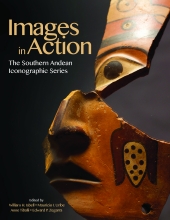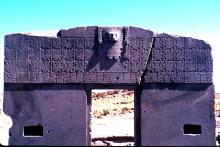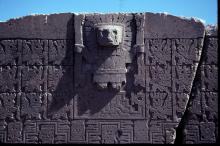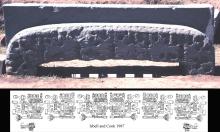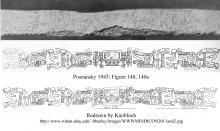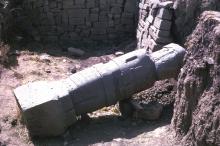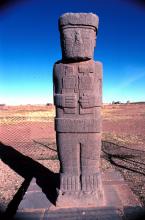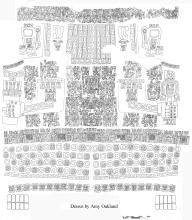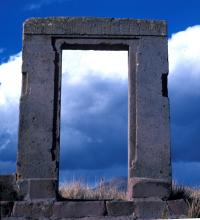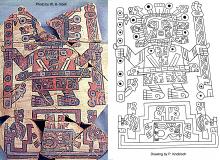Visual database
Sculpture from Tiahuanaco that precedes Late SAIS imagery and belongs to the Yaya-Mama style, defined by Karen and Sergio Chávez. The Rayed Head was popular in at least some Yaya-Mama representations, appearing in the most elaborate form of Yaya-Mama art, the Pucara style, in which a distinctive Sacrificer figure has been described as the "feline man" (Sergio Chávez, this volume, 2002). This Yaya-Mama statue was named the Bearded Statue by its discoverers, but comparison with other Andean imagery shows that it is actually wearing a large nose ring or mouthmask similar to many that appear in Nasca art.
Gate of the Sun, Tiahuanaco, showing all the icons sculpted on its front side.
Gate of the Sun, Tiahuanaco, detail, emphasizing the Late SAIS iconic triad. The Staff God appears in the center, larger than other images, and standing on a pyramidal pedestal. To his left and right are three rows of Profile Attendants, two with human and one with avian faces. At the bottom of the sculpted register are Rayed Heads, within a meander band, and each placed on a low pyramid pedestal.
Kantataita lintel, Tiahuanaco. Seriated as the earliest of the SAIS sculptures that all belong to the Tiwanaku Phase at Tiahuanaco. The lintel's severely damaged images are prototypical Profile Attendants. However, their formal attributes are consistent with sacrificers of Early SAIS art. The reconstructive drawing was prepared by Isbell and Cook (1987) from rubbings taken from the stone, but many details remain in question because of the extensive damage. Photo by William H. Isbell and drawing by William H. Isbell and Anita Cook (1987).
The Linares lintel is considered stylistically slightly later than the Kantataita lintel. It depicts two of the Late SAIS pantheon images, Staff God and Profile Attendants, although the attendants' formal attributes still relate very much to the early SAIS Sacrificer, and the incomplete Staff God figure might be intermediate between the Rayed Head and the Staff God. The photograph and upper reconstructive drawing were published by Arthur Posnansky (adapted from Posnansky 1945:Figures 140, 140a). The lower reconstruction was drawn by Patricia Knobloch (published with her permission) based on the Posnansky photograph and her knowledge of Tiwanaku-style art. The decision to hypothetically represent a complete but diminutive body with feet expresses her evaluation that there was sufficient space on the narrow lintel stone to include these elements (see http://www.rohan.sdsu.edu/~bharley/images/WWWMINDICON2011and2.jpg). If Knobloch is correct, the lintel's imagery anticipated the SAIS Staff God more than if the body were only partial and, consequently, more of an intermediate between Rayed Head and Staff God. However, there seems little doubt that this imagery reveals a step toward the Late SAIS pantheon so prominent in both Wari and Tiwanaku, but only two of the three supernaturals are present, the Staff God and Profile Attendants.
The Ponce Monolith, named for Bolivian archaeologist Carlos Ponce S., was discovered at Tiahuanaco by his excavation team, in fill near the center of the Kalasasaya mound, where it was probably interred by seventeenth-century extirpators of idolatries. It is assigned to the third phase of Late SAIS iconography at Tiahuanaco by Agüero, Uribe and Berenguer (2003), and it is the stylistically earliest monument to represent the entire Late SAIS triad, Staff God, Profile Attendants, and Rayed Head. This photo, taken by W. H. Isbell in 1964, shows the statue in the excavation pit where it was discovered.
The Ponce Monolith was eventually placed upright near the center of Kalasasaya platform, facing east. The body is represented as clad in elaborately decorated garments that are replete with SAIS imagery-Staff God, Profile Attendants, and Rayed Heads-as well as other symbols.
This reconstructive drawing of the imagery carved on the surface of the Ponce monolith was prepared by Amy Oakland, from rubbings and photographs (published with her permission). It shows the statue opened from the middle of the front to highlight the Staff God on the upper back, just below the snake-like bands that apparently represent the figure's braided hair. This is the stylistically earliest appearance of the SAIS triad at Tiahuanaco and shows a Staff God on the back and another on the headband, over the nose. Profile Attendants, now bereft of Sacrificer attributes, appear on the body, facing toward or away from the Staff God, and on the headband, marching toward the central Staff God from its right and left. Rayed Heads appear on the belt.
The architrave popularly called the Gate of the Moon is assigned to Phase 5, the end of the Late SAIS stylistic seriation at Tiahuanaco, by Agüero, Uribe, and Berenguer (2003). Other Phase 5 sculptures are the famous Gate of the Sun and the Llojeta Block.
The painted Staff God from a giant jar discovered at Conchopata in 1977, with a reconstructive drawing of the image drawn by Patricia Knobloch. This version of the deity icon is most similar to the Staff God carved on the Ponce monolith. The two must have been drafted from the same model and should therefore belong to the same time period. They synchronize Tiwanaku stylistic development with Wari stylistic chronology.
